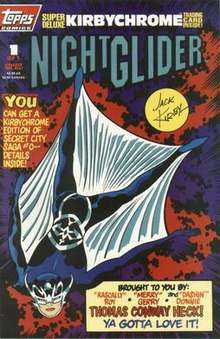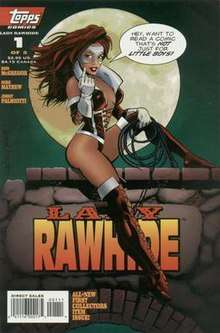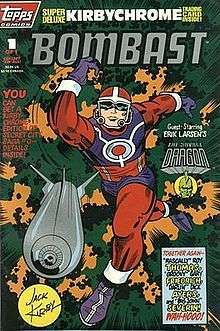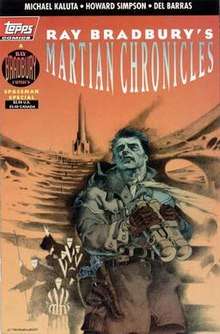Topps Comics
Topps Comics was a division of Topps Company, Inc. that published comic books from 1993 to 1998, beginning its existence during a short comics-industry boom that attracted many investors and new companies. It was based in New York City, at 254 36th Street, Brooklyn, and at One Whitehall Street, in Manhattan.
| Industry | Publishing |
|---|---|
| Genre | Science fiction, horror, swashbuckling adventure |
| Founded | March 1992[1] |
| Defunct | 1998[2] |
| Headquarters | , U.S. |
Key people | Jim Salicrup, EIC[1] |
| Products | Comic books[1] |
| Parent | Topps Company, Inc.[1] |
The company specialized in licensed titles, particularly movie and television series tie-ins, such The X-Files, based on the Fox TV show, and the films Bram Stoker's Dracula and Jurassic Park. It also licensed such literary properties as Zorro, and published a smattering of original series, including Cadillacs and Dinosaurs and several based on concepts by then-retired industry legend Jack Kirby.
History
In March 1992, Topps Company, Inc. announced the formation of Topps Comics, to be headed by Jim Salicrup, with plans to start publishing in October 1992.[1]
In April 1993, Topps launched a superhero line, "The Kirbyverse", based on Jack Kirby drawings and concepts, with four one-shot titles.[3]
Topps entered the comic book market as the number of publishers was increasing, with at least nine other companies joining the field from 1990 to 1992. This coincided with an increase in comic-book market-speculation that created inflated sales and an eventual collapse of the market. Topps Comics closed in 1998.[2]
Personnel
The editor-in-chief and associate publisher was Jim Salicrup.[1] Editors included Len Brown (co-creator of Topps' 1962 Mars Attacks cards), Howard Zimmerman, and Dwight Jon Zimmerman. The company's sales and promotions manager Charles S. Novinskie is listed as, additionally, a Topps Comics editor in his capsule biography at Non-Sport Update magazine.[4] The company's design director, Brian Boerner, is listed as Reprint Editor (along with Charles S. Novinskie) in the Xena trade paperbacks' credits.
Veteran comic-book scripter Tony Isabella, writing about difficulties with The X-Files creator Chris Carter over the Topps Comics' series, said in a 2000 interview,
[W]hoever was approving the comics over in Chris Carter Land were the poster kids for anal retentiveness. Although it's possible that they were so picky because they never wanted the comics out there in the first place. The main reason the comics fell behind schedule was because it took so long to satisfy the X-Files people. They went over everything with a fine-tooth comb, including the letters columns. . . . I rarely ran negative letters in these columns because the [Topps] editors were afraid that the X-Files people would want even more changes in the material. Almost from the start, there were never enough usable letters for our needs. That's why I started including the 'Deep Postage' news items — and making up letters completely. I also wrote the Xena letters columns, but those were a lot easier to produce.[5]
The Kirbyverse

The "Kirbyverse" comics, launched simultaneously with April 1993 cover-dates, stemmed from character designs and story concepts that the prolific Kirby, at this very late point in his life, had in his files of unrealized projects and preliminary sketches (some for Pacific Comics, which went defunct in the 1980s). Topps licensed them for an eight-title, interrelated mythos based around what became Jack Kirby's Secret City Saga. That flagship title was written by former Marvel Comics editor-in-chief Roy Thomas, with an issue #0 prequel drawn by artist Walt Simonson and the remainder of the series by Spider-Man co-creator Steve Ditko.
Kirby himself wrote and drew eight pages of the Satan's Six premiere, interlaced with story pages by writer Tony Isabella, penciler John Cleary and inker Armando Gil. Kirby's contribution may have been drawn in the 1970s, wrote one historian: "The 1970s was the flowering of Jack's interest in the paranormal. Freed from the restraints of more conservative collaborators, Jack delved into these themes with gusto. ... [He] developed 'Satan's Six' around this time, although it didn't see the light of day until the Topps Kirbyverse campaign in the 1990s."[6] As well, the covers of the Bombast, Captain Glory, and NightGlider[7] one-shot comics noted below were built around preexisting Kirby character designs.
Along with Secret City Saga and Satan's Six, the Kirbyverse titles were:
- Bombast, by plotter Thomas, scripter Gary Friedrich and artists Dick Ayers & John Severin
- Captain Glory, by writer Thomas and artist Ditko
- Jack Kirby's TeenAgents, by writer Kurt Busiek, penciler Neil Vokes, and inkers John Beatty and Jordi Ensign
- Jack Kirby's Silver Star, by writer Busiek, penciler James W. Fry III, and inker Terry Austin
- NightGlider, by plotter Thomas, scripter Gerry Conway, and artist Don Heck
- Victory, by writer Busiek, penciler Keith Giffen, and inker Jimmy Palmiotti
Kurt Busiek, in an undated interview, gave some background on the comics line:
Silver Star is a Jack Kirby character, originally done as a miniseries for Pacific [Comics]. Back when I was writing for the Topps Kirbyverse, I started two miniseries that were never completed, Victory and Silver Star, both of which got one issue published before the line collapsed. Victory was a crossover, bringing together all the established Kirbyverse characters and reintroducing Captain Victory [of the 1981–84 Pacific Comics series Captain Victory and the Galactic Rangers ] ... but Silver Star was a standalone project, one that was completely plotted and mostly scripted.[8]
In 2000, the Kirby estate said Dark Horse Entertainment had optioned Satan's Six as a film property.[9]
In 2011, Dynamite Entertainment published a comic book series titled Kirby: Genesis that represented a reboot of the Kirbyverse.[10]
List of Topps Comics



Note: Most, but not all, were designed as limited series.
Original series
- The Barbi Twins Adventures #1 (July 1995)
- Cadillacs and Dinosaurs #1–9 (Feb.-Nov. 1994)
- Lady Rawhide (original spinoff of Zorro), #1–5 (miniseries; July 1995 – March 1996)
- Lady Rawhide vol. 2, #1–5 (miniseries;Oct. 1996 – June 1997, preview ashcan comic inserted in Wizard)
Kirbyverse comics
- Bombast #1 (April 1993 one-shot)
- Captain Glory #1 (April 1993 one-shot)
- Jack Kirby's Secret City Saga #0–4 (April–Aug. 1993)
- Jack Kirby's Silver Star #1 (planned four-issue miniseries, truncated)
- Jack Kirby's TeenAgents #1–4 (Aug.-Nov. 1993)
- Night Glider #1 (April 1993 one-shot)
- Satan's Six #1–4 (April–July 1993)
- Satan's Six: Hellspawn #1–3 (months n.a., 1994)
- Victory #1 (June 1994; planned five-issue miniseries, truncated)
Literary adaptations/tie-ins
- Bill, the Galactic Hero
- The Dracula Chronicles
- Dracula Versus Zorro #1–2
- Dracula: Vlad the Impaler (Feb.-April 1993)
- Elric #0 – One Life (Aug. 1996)
- Elric: Stormbringer
- The Frankenstein / Dracula War #1–3
- Ray Bradbury Comics #1–5 (Feb.-Oct. 1993)
- Ray Bradbury's The Illustrated Man #1, a.k.a. prefixed A Ray Bradbury Comics Special:
- Ray Bradbury's Martian Chronicles #1 (June 1994), a.k.a. prefixed A Ray Bradbury Comics Special:
- Ray Bradbury's Tales of Terror #1 (May 1994), a.k.a. prefixed A Ray Bradbury Comics Special:
- Zorro #1–11
Movie adaptations/tie-ins
- Bram Stoker's Dracula #1–4 (Oct. 1992 – Jan. 1993)
- Dragonheart #1–2
- Jackie Chan's Spartan X: The Armour of Heaven
- James Bond, 007 / Goldeneye
- Jason Goes to Hell: The Final Friday
- Jason vs. Leatherface #1–3
- Jurassic Park #0–4
- Jurassic Park: Raptor #1–2
- Jurassic Park: Raptors Attack #1–4
- Jurassic Park: Raptors Hijack #1–4
- Jurassic Park Annual #1
- Mary Shelley's Frankenstein
- Return to Jurassic Park #1–9
- The Lost World: Jurassic Park #1–4
- Star Wars: Tales of the Jedi: Dark Lords of the Sith / Topps Special Ashcan Edition
TV/radio adaptations/tie-ins
- Duckman #1–5 (Nov. 1994 – n.a. ) plus #0
- Duckman Duckman: The Mob Frog Saga #1–3 (miniseries; Nov. 1994 – n.a. )
- Exosquad #0–1
- Hercules: The Legendary Journeys #1–5 (June–Oct. 1996)
- The Lone Ranger and Tonto #1–4
- The Marriage of Hercules and Xena
- Space: Above and Beyond
- Space: Above and Beyond — The Gauntlet
- The X-Files #1–41 (Jan. 1995 – Sept. 1998), plus #0 (an adaptation of the series' pilot episode)
- The X-Files Annual #1–2 (Aug. 1995; 1996)
- The X-Files Comics Digest #1–3 (Dec. 1995 – n.a.)
- The X-Files: Ground Zero #1–4 (Dec. 1997 – March 1998)
- Xena: Warrior Princess vs. Callisto
- Xena: Warrior Princess/Joxer: Warrior Prince
- Xena: Warrior Princess: The Dragon's Teeth
- Xena: Warrior Princess and the Original Olympics
- Xena: Warrior Princess: Bloodlines
- Xena: Warrior Princess: The Orpheus Trilogy
- Xena: Warrior Princess: The Wrath of Hera
- Xena: Warrior Princess: Year One
Trading-card adaptations/tie-ins
- Mars Attacks #1–5 (miniseries)
- Mars Attacks (vol. 2) #1-7
- Mars Attacks #1/2 (with Wizard magazine)
- Mars Attacks: Wizard Ace Edition #65 (with Wizard magazine)
- Mars Attacks Baseball Special #1
- Mars Attacks High School #1–2
- Mars Attacks/The Savage Dragon #1–4
- Mars Attacks/Image #1-4
Other
- Topps Comics Presents
References
- Bryant, Adam (March 27, 1992). "COMPANY NEWS; Topps to Start Publishing Comic Books". The New York Times. Retrieved November 14, 2012.
- Gabilliet, Jean-Paul; translated by Bart Beaty; Nick Nguyen (2009). "The Collapse of 1993–1996". Of Comics and Men: A Cultural History of American Comic Books. University Press of Mississippi. pp. 148–151. ISBN 978-1604732672.
- "Twilight at Topps". The Collected Jack Kirby Collector. TwoMorrows Publishing. 5: 149–152. 2006.
- "Who's Who at NSU", Non-Sport Update, n.d. WebCitation archive.
- Coville, Jamie (May 2000). "An Interview with Tony Isabella". Collector Times. 5 (2). Archived from the original on January 20, 2002. Retrieved 2007-07-23.
- Knowles, Chris (December 1996). "The Kirby-Files: An Overview of Jack's Occult and Supernatural Themes". Jack Kirby Collector (13). Archived from the original on September 5, 2001.
- Sources disagree on its spelling, sometimes even within the same source: The cover of the single issue itself appears to spell it "NightGlider". The cover of Victory #1 likewise spells it as one word, though in an all-caps typeface. The Grand Comics Database entry spells it as both "Nightglider" and "Night Glider". The archived pulldown title-search menu at the Jack Kirby Museum site spells it "Night Glider"
- "20 Questions with Kurt Busiek". SlushFactory.com. n.d. Archived from the original on June 13, 2002.
- "Tracy Kirby Interview". Jack Kirby Collector (28). April 2000. Archived from the original on February 11, 2001.
- "Kirby: Genesis". Comic Book Resources. May 29, 2011. Retrieved December 16, 2016.
External links
- "Jack Kirby: A By-the-Month Chronology: 1980–1995". MarvelMastworks.com, n.d. WebCitation archive.